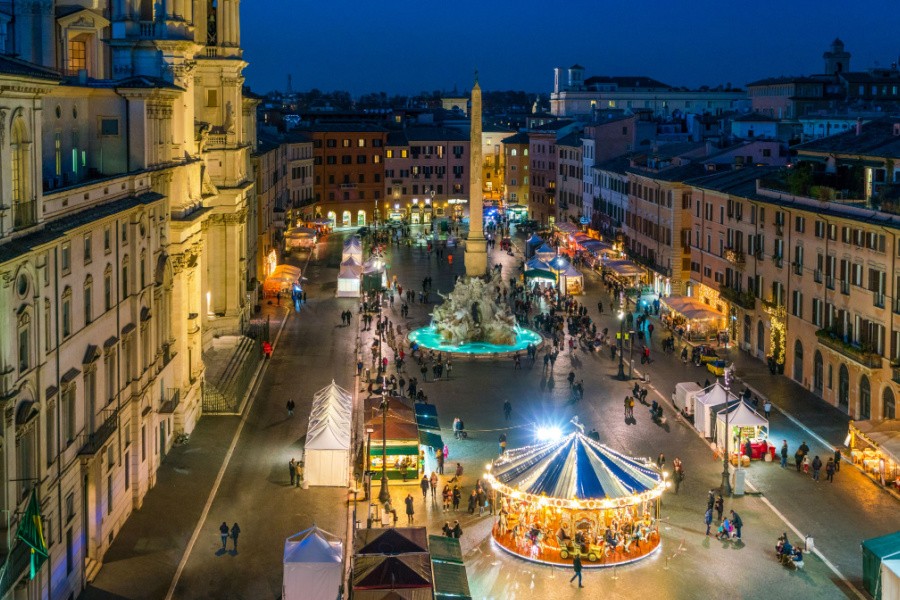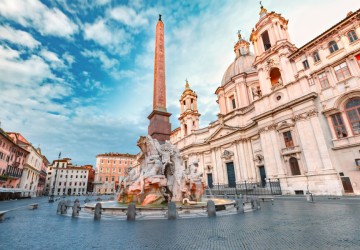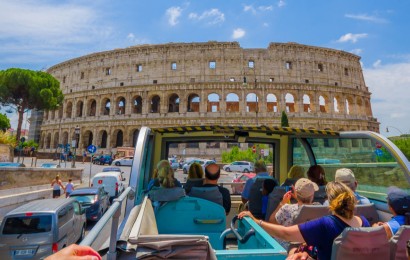One of the most famous monumental squares of Rome is Piazza Navona, certainly one of the most famous of the city, and tourist attraction center for its architectural beauties, for its sculptural fountains and for the entertainment that for children and adults is always ready to give.
Masterpiece of the Roman Baroque, Piazza Navona, houses the works of Gian Lorenzo Bernini, Francesco Borromini and Girolamo Rainaldi, artists and sculptors of unique and inimitable artistic ability.
However, not everyone knows its history and the curiosities that are linked to history to the tradition of Piazza Navona. Let’s see them together.
The history of Piazza Navona
At the time of ancient Rome, Piazza Navona was the Stadium of Domitian built by the Emperor himself in 85 AD.
The stadium was 265 metres long, 106 metres wide and was estimated to hold 30,000 spectators.
The square was built on the perimeter of the ancient stadium, for this has an elongated rectangular shape. Currently the level of the square is raised about 6 meters from the previous one.
Its name was originally "in Agone" (from the Latin "in agonis" which means "games"), because the stadium was intended for athletes. Here, in fact, there were all kinds of challenges such as boxing, poetry, athletics and then fights between gladiators. But there were places for the most unbridled and out of line Roman fun and for this, the square was also surrounded by taverns taverns and brothels.
Over the centuries it has been the scene of many popular festivals, races and rides. After the fall of the Roman Empire the square came back to life as one of the main open-air markets of the city.
What to see in Piazza Navona?
Piazza Navona is the symbol of Baroque Rome. You can visit Piazza Navona with our panoramic tour by bus, getting off at stop number 6 of "Vatican City". Or you can book a tour of Rome by night and see this and other important monuments of Rome illuminated and surrounded by a romantic and magical atmosphere. The square has three fountains and an obelisk and a magnificent church located right in front of the Bernini fountain: the church of Sant'Agnese in Agone.
Piazza Navona is bordered by the extraordinary Baroque buildings: the Church of Sant'Agnese in Agone with its obelisk, Palazzo Braschi and Palazzo Panghilj. But what is most striking in the square is certainly the complex of three fountains, masterpieces of architecture and sculpture, famous all over the world with the title of "The Fountains of Piazza Navona".
The Church of Sant'Agnese in Agone
The church of Sant'Agnese in Agone is a Catholic church dedicated to Saint Agnes. The project was designed by Girolamo Rainaldi in 1652 commissioned by Innocent X Pamphili. The works continued under the direction of Francesco Borromini and were finished in 1672 by the architect’s son, Carlo Rinaldi. According to legend, the church is located in the place where the martyrdom of the Saint took place.
A visit to the museum of Palazzo Braschi
Located between Piazza Navona and Corso Vittorio Emanuele II, in the heart of Renaissance Rome, you can not miss a visit to Palazzo Braschi, Museum of Rome, which brings together a wide variety of works of art related to the history of the city of the Medieval period, and the first half of the 20th century.
The museum’s collection contains many objects, furniture, engravings and works ranging from cultural, topographical, architectural, social and artistic history of the capital.
The collection of paintings is the most important and of great documentary value, produced between the sixteenth and eighteenth centuries, for religious ceremonies and civil events.
The sculptural section is instead characterized by monumental works, busts, sketches and clay models.
Another large collection consists of drawings and watercolors, prints, engravings and books that testify to the history and evolution of the topography of the city.
→ If you are in Rome during the holidays and you are walking through the streets of the historic center of Piazza Navona, until February 5, you can visit the exhibition of over 160 works, including mosaics, frescoes and works that tell the medieval Rome from Roman places and collections, to bring tourists and citizens closer to the riches of the city.
The fountains of Piazza Navona
Piazza Navona is equipped with three fountains and an obelisk that rises to 16 meters.
Fontana del Moro, is the oldest of the three fountains and was sculpted in 1654 by master Ludovico Rossi of Fiesole. The work owes its name to the statue of the Ethiopian fighting with a dolphin.
Fountain of Neptune, commissioned by Pope Gregory XIII and designed by Giacomo della Porta in 1574. The work was not completed and remained without sculptures for about 300 years. Antonio dell'Bitta created the sculpture of the water god Neptune with his trident fighting with an octopus. The other sculptures, representing sea horses, mermaids and playing with dolphins, were made by Gregorio Zappalà.
Fontana dei Quattro Fiumi, the largest of the three fountains in Piazza Navona. Designed by Gian Lorenzo Bernini between 1648 and 1651 A.D. The fountain is designed as a travertine cliff supporting the large obelisk. On the corners of the cliff there are marble statues of the four rivers of the continents then known: the Danube for Europe, the Ganges for Asia, the Nile for Africa and the Rio della Plata for America.
The Christmas markets in Piazza Navona

Today Piazza Navona is the center of Roman nightlife, with many bars, street artists and home to one of the most famous events of the Christmas holidays: the Christmas markets.
If you want to take a tour of the Christmas markets in Rome, you can not miss the Christmas markets in Piazza Navona.
Both day and night you can find stalls of all kinds, with toys, Christmas decorations, typical products and much more.
In the square, on December 6, is also celebrated the Feast of the Epiphany, with many programs and activities for young and old.
Piazza Navona: facts and curiosities
Around Piazza Navona there are many facts, curiosities and legends:
- It is said that the Church of S.Agnese in Agone was founded on the place where in 304 A.D. the young Agnese was martyred, guilty of having rejected the son of the prefect of Rome and then denounced as a Christian. She was stripped naked and her hair grew miraculously to cover her entire body. No one dared to violate his virginity after the only one who tried it fell electrocuted at his feet; Initially she was thrown into the fire but this died after her prayers. So, she was killed in the same way that the lambs were killed, that is pierced by a sword shot to the throat;
- According to a legend at the time, there was a strong rivalry between the two major architects of the time: Borromini and Bernini. Tradition has it that the poses of the statues of the Nile and the Rio della Plata in the Fountain of the four rivers, as well as those of the statue of Saint Agnes, were placed in that way for a reason.
The Rio della Plata would have its hand raised to shelter from the collapse of the facade of the Church of Sant'Agnese in Agone while the Nile would have its head veiled as a form of refusal to see the work of Borromini. Moreover, according to the inhabitants of Rome, Sant'Agnese’s gesture of touching his chest with his hand, represents a reassurance that Borromini himself wanted to give about the fact that his church would not fall; - Piazza Navona was also dedicated to the market, so it was home to many activities including the feast of cuccagna. In fact, one of the streets around Piazza Navona is called Via della Cuccagna, in memory of this game;
- During the summer months, Pope Innocent had arranged the so-called "water games". He ordered to block the drains of the sewage system so that the water from the fountains overflowed and the entire square flooded. In addition to the games, the real reason was to be able to recall famous naval battles (the famous Naumachie of the Romans);
- In 1634, the "Giostra del Saracino" of medieval tradition was organized in the square. This is the classic challenge between two riders, equipped with armor and rod, who faced each other along a predetermined path;
- Around Piazza Navona lies the legend of lovers. According to this legend, in past times, a witch cast a curse on the Fountain of the Four Rivers. The curse is that all lovers who turn counterclockwise around the fountain leave within six days.
Movies shot in Piazza Navona
Rome is one of the main cities on the big screen. Piazza Navona also contributed to some of the most beautiful scenes in the history of cinema, including:
- Yesterday, today, tomorrow
- The talent of Mr. Ripley
- The great beauty
- Eat, pray, love
- Angels and demons

